Westerbork transit camp
Camp Westerbork (Dutch: Kamp Westerbork, German: Durchgangslager Westerbork) was a transit camp in Drenthe province, northeastern Netherlands, during World War II.[1] Established by the Dutch government in the summer of 1939, Camp Westerbork was meant to serve as a refugee camp for Jews who had illegally entered the Netherlands.[1][2]
| Westerbork | |
|---|---|
| Transit camp | |
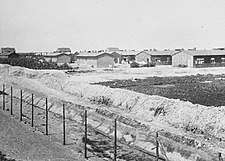 Barracks at Westerbork after liberation | |
 Location of Westerbork within Netherlands | |
| Coordinates | 52°55′3″N 6°36′26″E |
| Other names | Polizeiliches Durchgangslager Westerbork, Judendurchgangslager Westerbork |
| Location | Westerbork, the Netherlands |
| Operated by | SS |
| Original use | Refugee camp |
| Operational | 1 July 1942–12 April 1945 |
| Inmates | Jews |
| Number of inmates | 97,776 deported, mostly to Auschwitz and Sobibór; 876 liberated |
| Liberated by | Canadian 2nd Infantry Division |
| Notable inmates | Anne Frank, Dora Gerson, Etty Hillesum, Philip Slier, Edith Stein, Selma Wijnberg-Engel, Max Ehrlich, Wilhelm Mautner, Ellen Burka |
| Notable books | The night of the Girondins |
| Website | www |

Purpose of Camp Westerbork
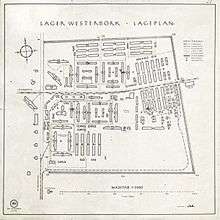
Camp Westerbork was utilized as a staging ground for the deportation of Jews.[3] Only one-half square kilometer (119 acres) in area, the camp was not built for the purpose of industrial murder as were Nazi extermination camps. Westerbork was considered by Nazi standards as “humane”.[3] Jewish inmates with families were housed in 200 interconnected cottages that contained two rooms, a toilet, a hot plate for cooking, and a small yard. Single inmates were placed in oblong barracks which contained a bathroom for each sex.[2][3]
Transport trains arrived at Westerbork every Tuesday from July 1942 to September 1944, and deported an estimated 97,776 Jews during the period.[1] Jewish inmates were deported in waves to Auschwitz (65 train-loads totaling 60,330 people), Sobibor (19 train-loads; 34,313 people), Theresienstadt ghetto, and Bergen-Belsen concentration camp (9 train-loads; 4,894 people).[2][1] Almost all of the 94,643 persons deported to Auschwitz and Sobibor in German-occupied Poland were killed upon arrival.[1]
Camp Westerbork also had a school, orchestra, hairdresser, and even restaurants designed by SS officials to give inmates a false sense of hope for survival and to aid in avoiding problems during transportation.[2] Cultural activities provided by the Nazis for designated deportees included metalwork, jobs in health services, and other cultural activities.[2] A special, separate work cadre of 2,000 “permanent” Jewish inmates was used as a camp labor force.[1] Within this group was a sub-group constituting a camp police force which was required to assist with transports and keep order.[1] The SS actually had very little to do with selecting transferees; this job fell to another class of inmates that made up a sort of security service.[2] Most of these 2,000 "permanent" inmates were eventually sent to concentration or death camps themselves.[1]

Notable prisoners
Notable prisoners in Westerbork included Anne Frank, who was transported to Camp Westerbork on August 4, 1944[4] and Etty Hillesum, each of whom wrote of their experiences in diaries discovered after the war.[5] Anne remained at the camp in a small hut until September 3, when she was deported to Auschwitz.[4]
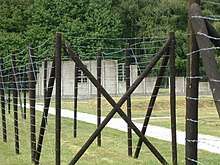
Etty Hillesum was able to avoid the Nazi dragnet that identified Jews until April 1942.[6] Even after being labeled a Jew, Hillesum began to report on antisemitic policies. She took a job with Judenrat for two weeks and then volunteered to accompany the first group of Jews sent to Westerbork.[5][6] Hillesum stayed at Westerbork until September 7, 1943, when she was deported to Auschwitz. She died there three months later.[6]
Camp Westerbork also housed German film actress and cabaret singer Dora Gerson, who was interned there with her family before being sent to Auschwitz, and Professor Sir William Asscher, who survived the camp when his mother secured his family's release by fabricating English ancestry. Jona Oberski wrote of his experience as a small child at Westerbork in his book, Kinderjaren ("Childhood"), published in the Netherlands in 1978 and later made into the film, Jonah Who Lived in the Whale.
Maurice Frankenhuis chronicled his family's experiences while interned in Westerbork and in 1948 conducted an interview with its Commander Albert Gemmeker while awaiting trial.[7] The published interview in Dutch and English became the basis for a docudrama created in September 2019.[8] The film features colorization of original video of transports from Westerbork by photographer Rudolf Breslauer.
Leadership within the Camp
Jacques Schol, a Dutchman, was commander of the camp from July 16 1940 and until January 1943. He was known for his brutality against Jewish inmates, kicking inmates to death.[9]
German authorities took control of Westerbork from the Dutch government on July 1, 1942.[1] Deportations began under the orders of Gestapo sub-Department IV-B4, which was headed by Adolf Eichmann.[3] Within the confines of the camp, German SS commanders were in charge of inmates, but squads of Jewish police and security were used to keep order and aid in transport, as noted above.[10]
Liberation
Transports came to a halt at Camp Westerbork in September 1944.[2] Allied troops neared Westerbork in early April, 1945 after German officials abandoned the camp. Westerbork was liberated by Canadian forces on April 12, 1945. A total of 876 inmates were found.[2]
Post World War II
Following the war, Westerbork was first used as a remand prison for alleged and accused Nazi collaborators, and later housed Dutch nationals who fled the former Dutch East Indies (Indonesia).
Westerbork was completely disassembled in the 1960s by the Dutch government.[2] Later, the Dutch built the Westerbork Synthesis Radio Telescope, a large radio telescope, on the site. Only the former camp commander’s house has been preserved, in a glass container.[2]
Historiography
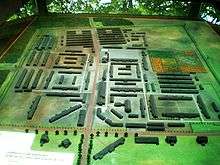
In 1950, the Dutch government appointed Jewish historian Jacques Presser to investigate the events connected with the mass deportation of Dutch Jewry and the extent of the collaboration by the non-Jewish Dutch population. The results were published fifteen years later in The Catastrophe (De Ondergang). Presser also published a novel, The Night of the Girondins, which was set in Westerbork.
Holding Place for Moluccan Refugees
In 1949, when the Dutch left their over 300 year occupation of Indonesia, native Indonesians were left in political unrest. Some people who had collaborated with French, Algerian, and Dutch militaries were evacuated, because they were the subject of anger by the other indigenous people who had resisted colonization and felt betrayed at the Moluccan peoples siding with their colonizers. The peoples were promised a quick return to their homeland. However, from 1951 to 1971, former indigenous Moluccan KNIL soldiers and their families were made to stay in the camp. During this time, the camp was renamed Kamp Schattenberg.[11]
Memorials
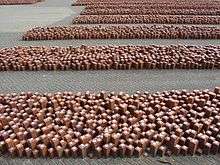
A museum was created two miles from Westerbork to keep the memories of those imprisoned in the camp alive.[2] As a tribute to those inmates who had died after deportation, a memorial was commissioned;[2] it consists of 102,000 stones, representing each person who was deported from Westerbork and never returned. The National Westerbork Memorial was unveiled at the site by Queen Juliana of the Netherlands on 4 May 1970.[12][13] Also, a monument of a broken railroad track torn from the ground is displayed near the camp to symbolize the destruction the camp, as well as others, wrought on the European Jewish population, and the determination that the tracks would never again carry people to their deaths.[13]
In 2017, films commissioned by the German camp commander Albert Gemmeker from a Jewish prisoner, Rudolf Breslauer, to document everyday life in the Westerbork transit camp, were submitted by the Netherlands and included in UNESCO's Memory of the World Register.[14]
References
- Holocaust Encyclopedia. "Westerbork". United States Holocaust Memorial Museum.
- Project Aice. "Westerbork Transit Camp". Jewish Virtual Library. Retrieved 28 February 2018.
- Boas, Jacob (1985). Boulevard Des Miseres The Story of Transit Camp Westerbork. Hamden, Connecticut: Archon Books. pp. 3–32. ISBN 0208019774.
- Prose, Francine (2009). Anne Frank: The Book, The Life, The Aftermath. New York, New York: Harper Collins. pp. 53–59.
- De Costa, Denise (1998). Anne Frank and Etty Hillesum Inscribing Spirituality and Sexuality. New Brunswick, New Jersey: Rutgers University Press. pp. 167–191. ISBN 0813525500.
- Hanan, Frenk. "Etty Hillesum". Jewish Women's Archive. Retrieved 20 April 2018.
- en.wikipedia.org https://en.wikipedia.org/wiki/Maurice_Frankenhuis. Missing or empty
|title=(help) - https://www.dvhn.nl/drenthe/midden-drenthe/Premi%C3%A8re-korte-speelfilm-Gemmeker-met-historische-transportbeelden-in-kleur-24815045.html. Missing or empty
|title=(help) - Ballis, Anja (2019). Holocaust Education Revisited. Springer. p. 114.
- "Camp Westerbork". Kamparchieven. Retrieved 20 March 2018.
- Polakow-Suransky, Sasha (2017). Go Back to Where You Came From: The Backlash Against Immigration and the Fate of Western Democracy. Nation Books. p. 19. ISBN 1568585926.
- "Jodenvervolging: Nationaal Monument Westerbork". Drenthe in de oorlog (in Dutch). Retrieved 2019-02-08.
Het Nationaal Monument Westerbork wordt op 4 mei 1970 officieel door Koningin Juliana onthuld
- "The National Westerbork Memorial". Herinneringscentrum Kamp Westerbork. Retrieved 1 May 2018.
- "Westerbork films". Memory of the World. United Nations Educational, Scientific and Cultural Organization. Retrieved 2018-10-09.
- Herbstrith, W. (1983). Edith Stein: A biography (5th rev. ed.) (Trans. B. Bonowitz). San Francisco, CA: Harper & Row Publishers.
Further reading
- Hans-Dieter Arntz: Der letzte Judenälteste von Bergen-Belsen. Josef Weiss - würdig in einer unwürdigen Umgebung. Aachen 2012.
- Jacob Boas, Boulevard des Misères: the Story of the Transit Camp Westerbork. Hamden, Connecticut: Archon Books, 1985 ISBN 0-208-01977-4
- Etty Hillesum, Letters from Westerbork. New York: Pantheon, 1986 ISBN 0-394-55350-0 (originally published in the Netherlands as Het denkende hart van de barak, 1982)
- Cecil Law, Kamp Westerbork, transit camp to eternity : the liberation story. Clementsport, N.S. : Canadian Peacekeeping Press, 2000 ISBN 1896551351
- Harry Mulisch, The Discovery of Heaven. Penguin Press, 1992, ISBN 0-1402-3937-5
- Jacob Presser, The Destruction of the Dutch Jews New York: Dutton, 1969, translated by A. Pomerans.
External links
| Wikimedia Commons has media related to Kamp Westerbork. |